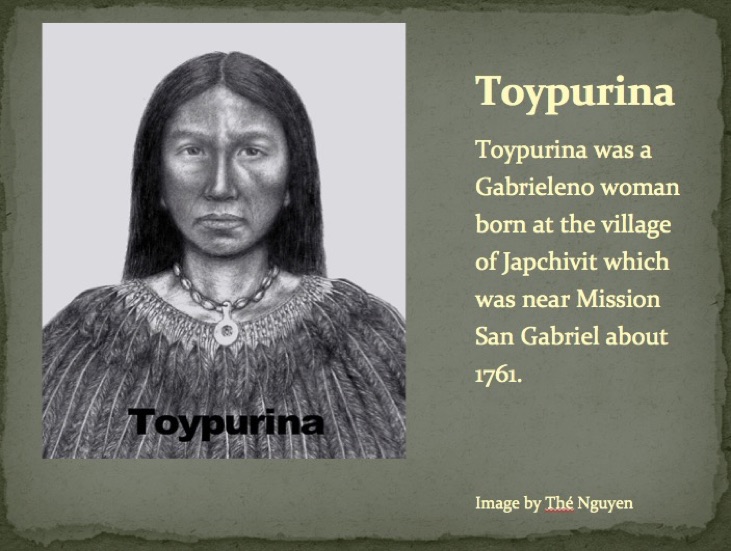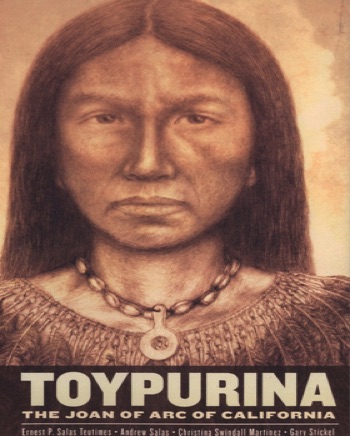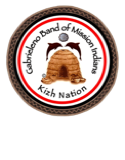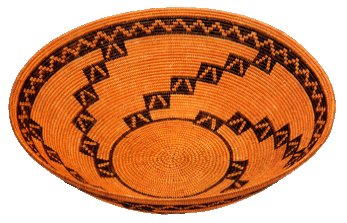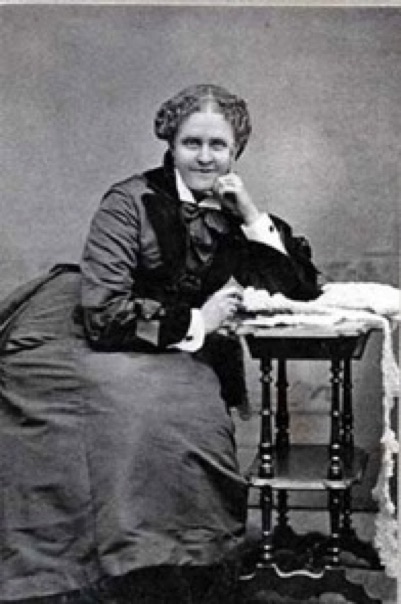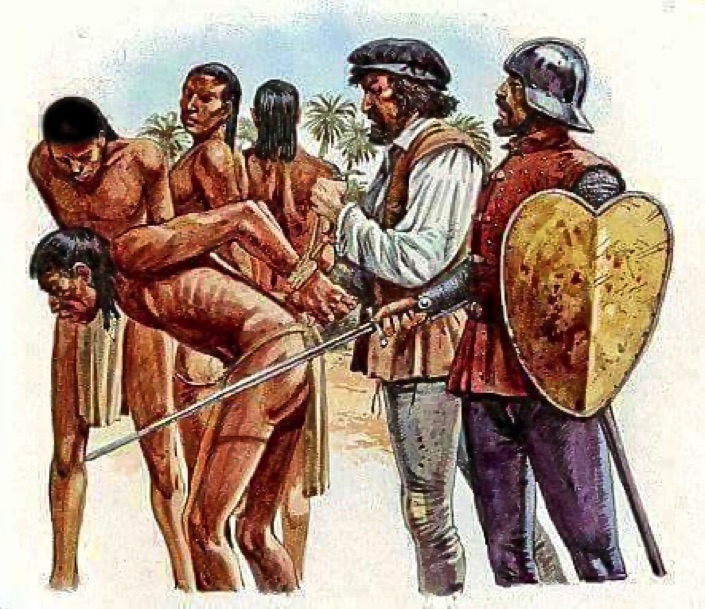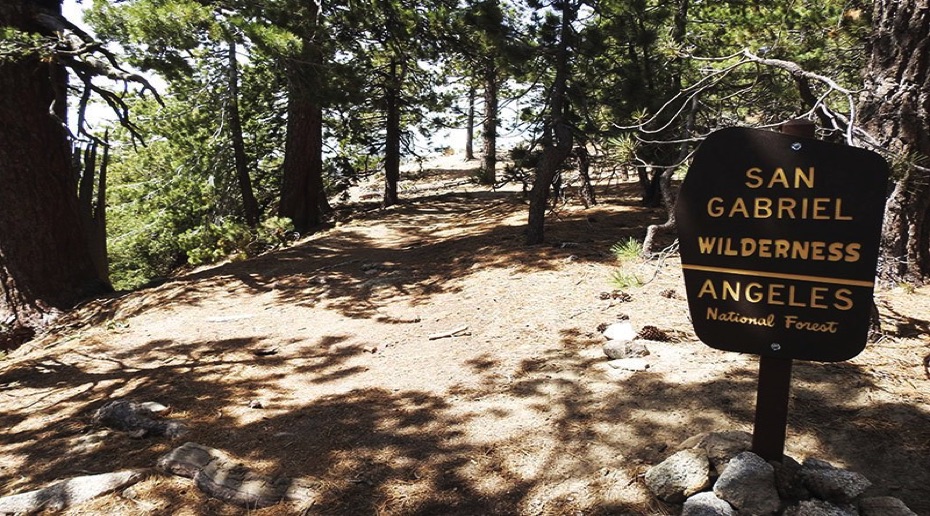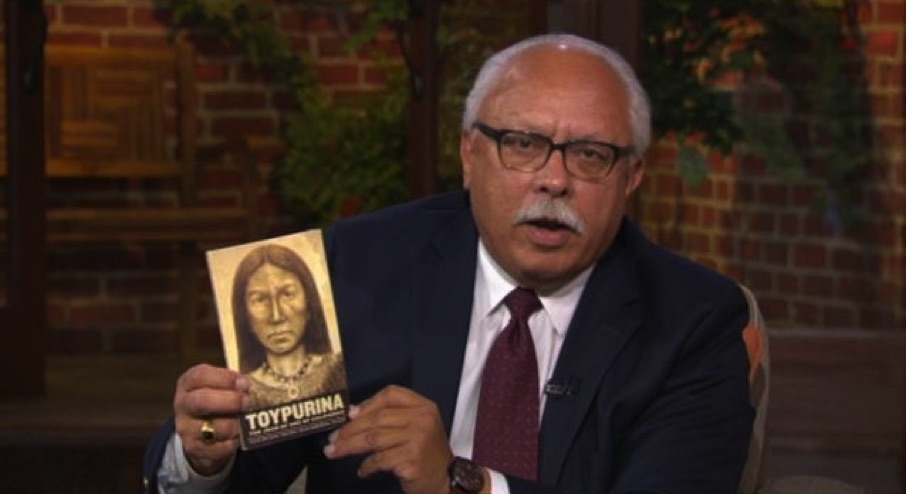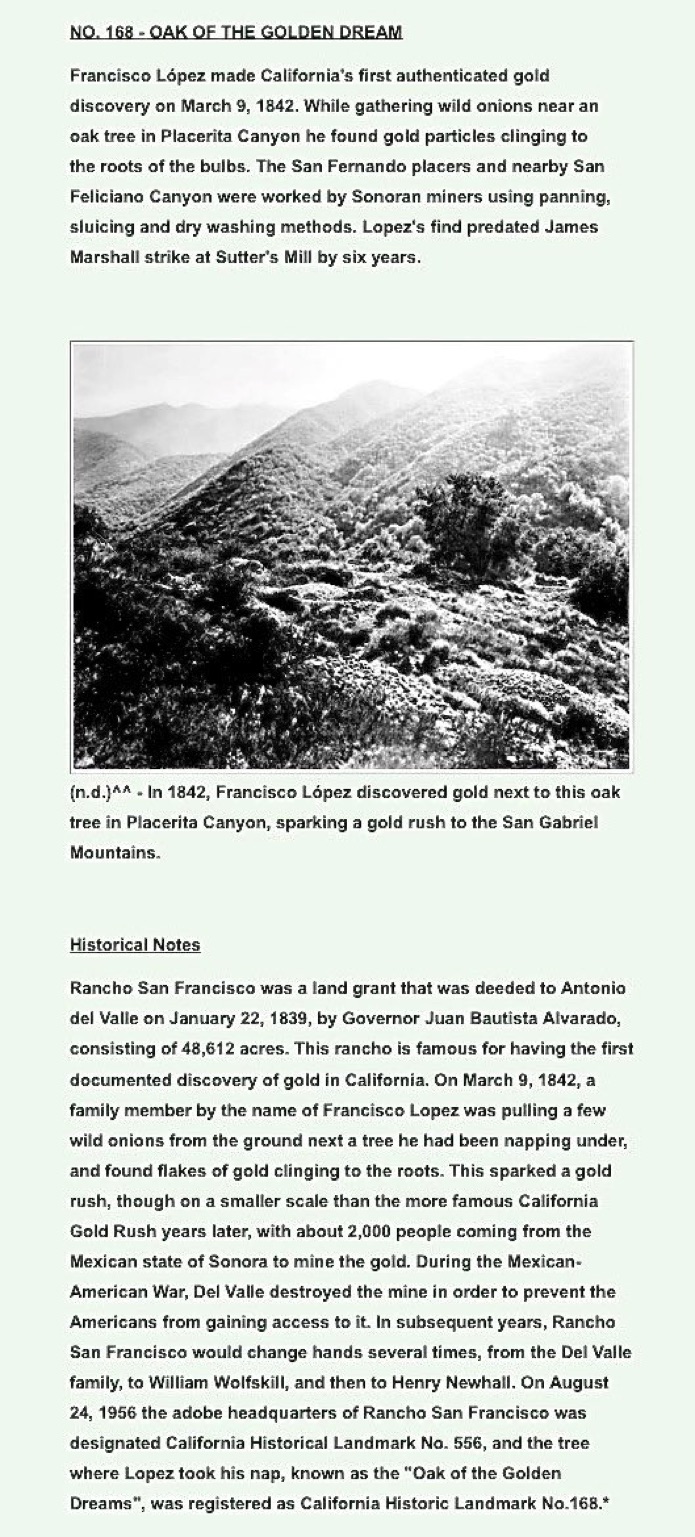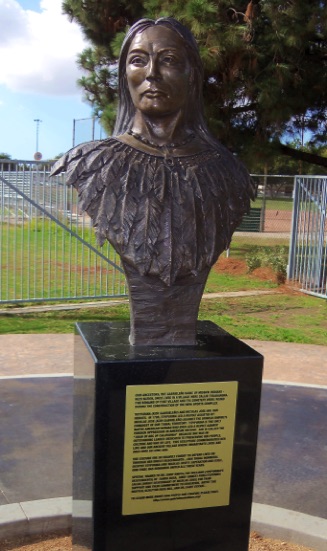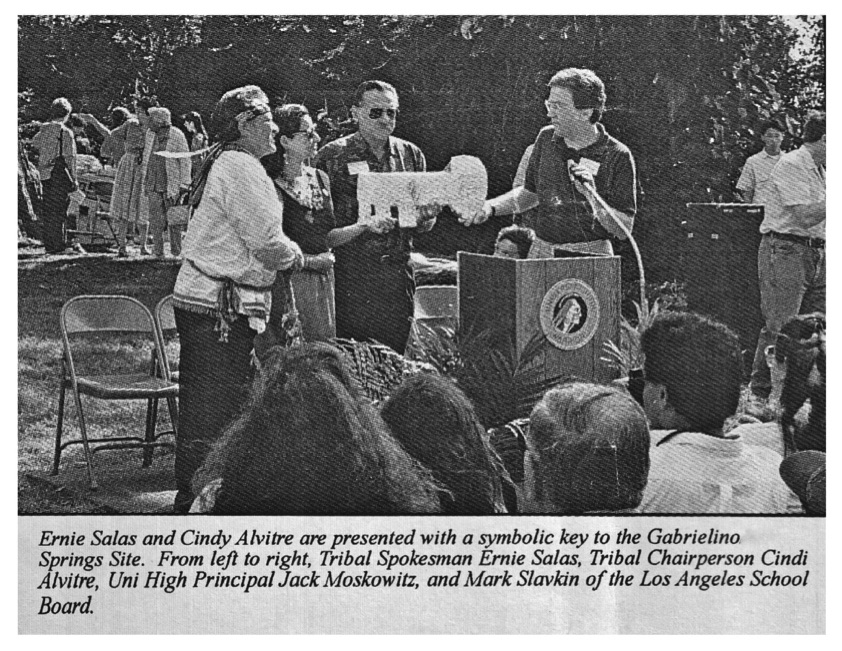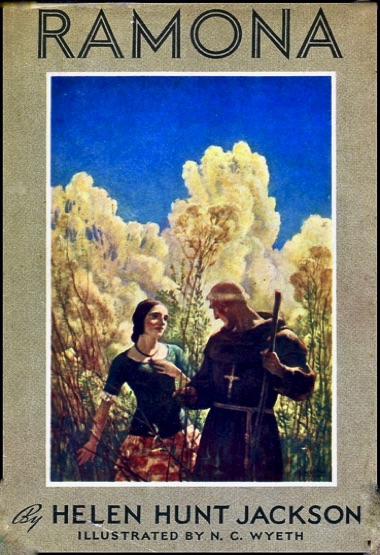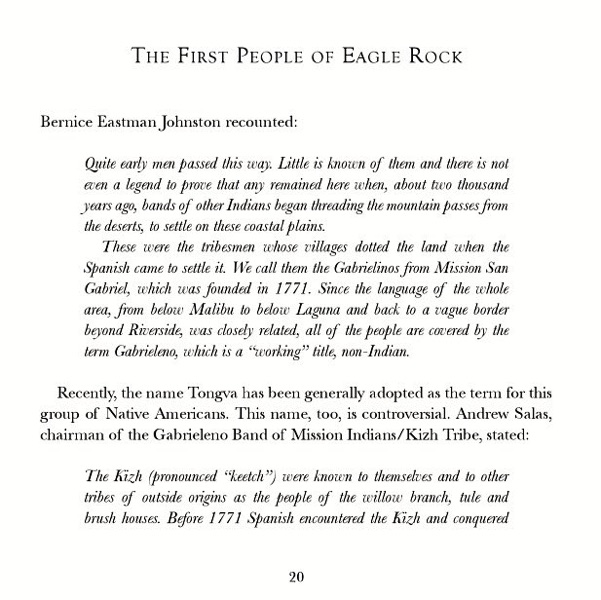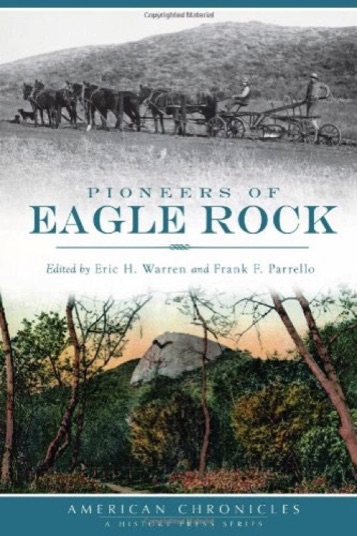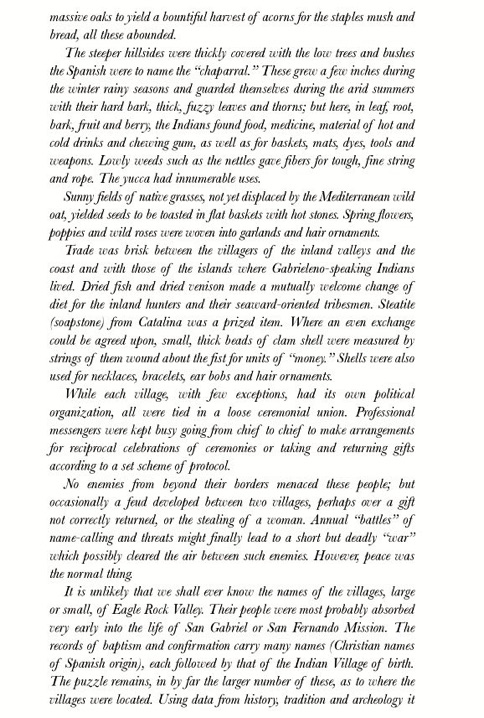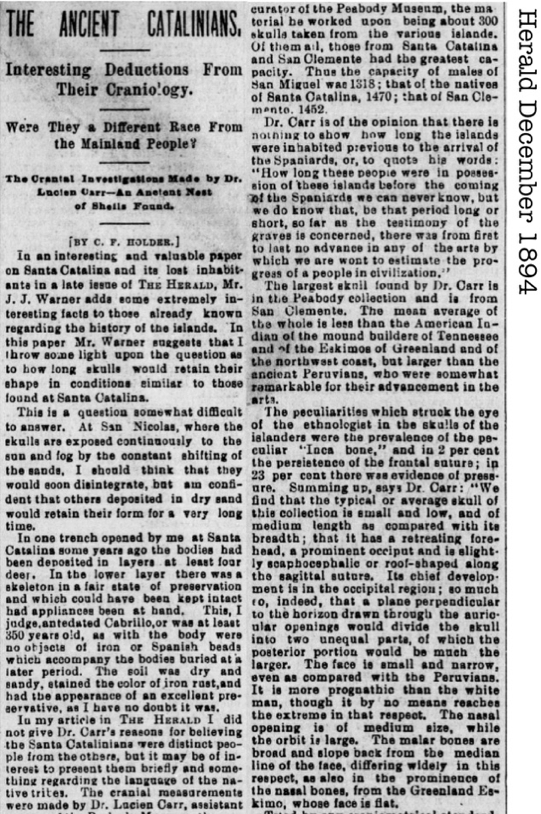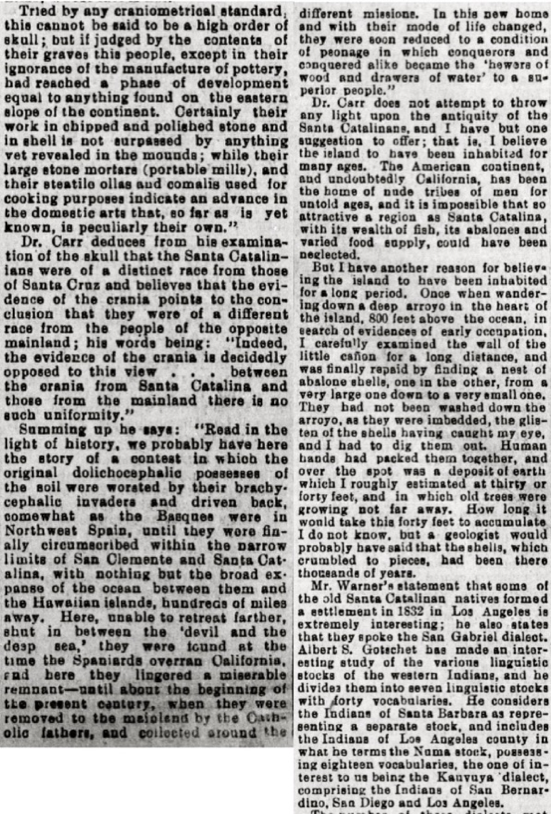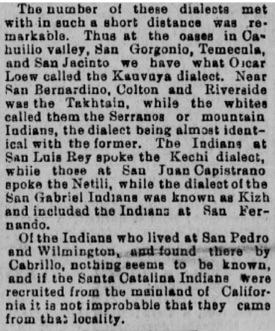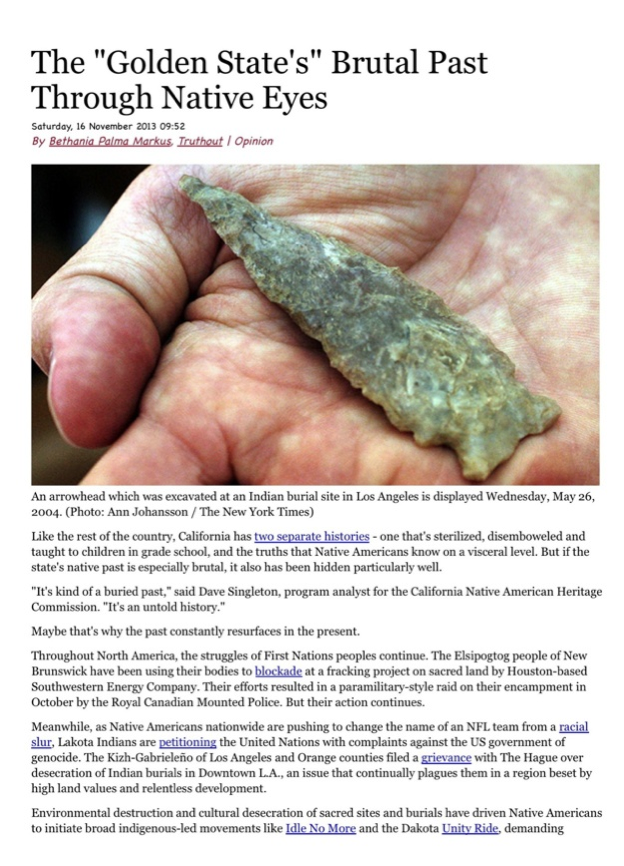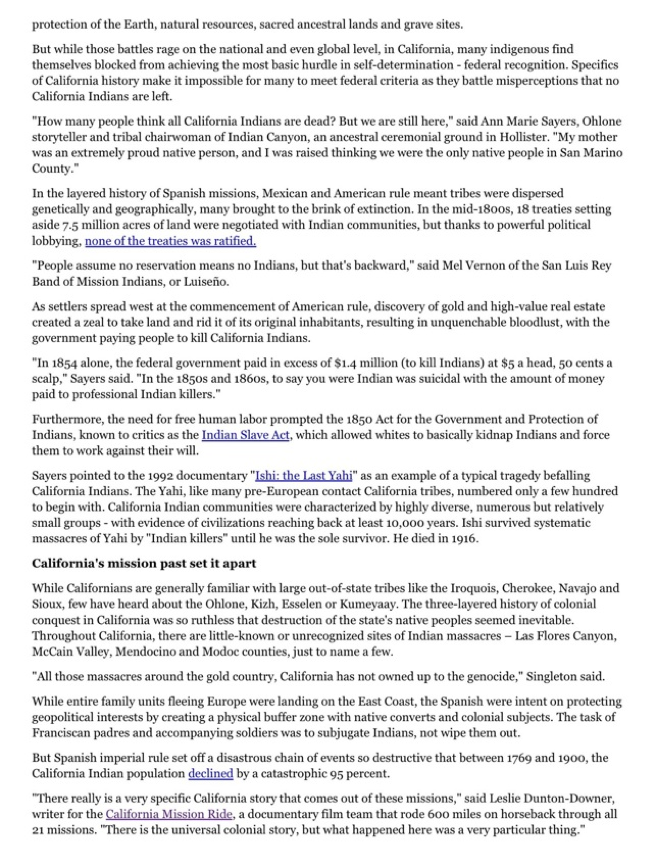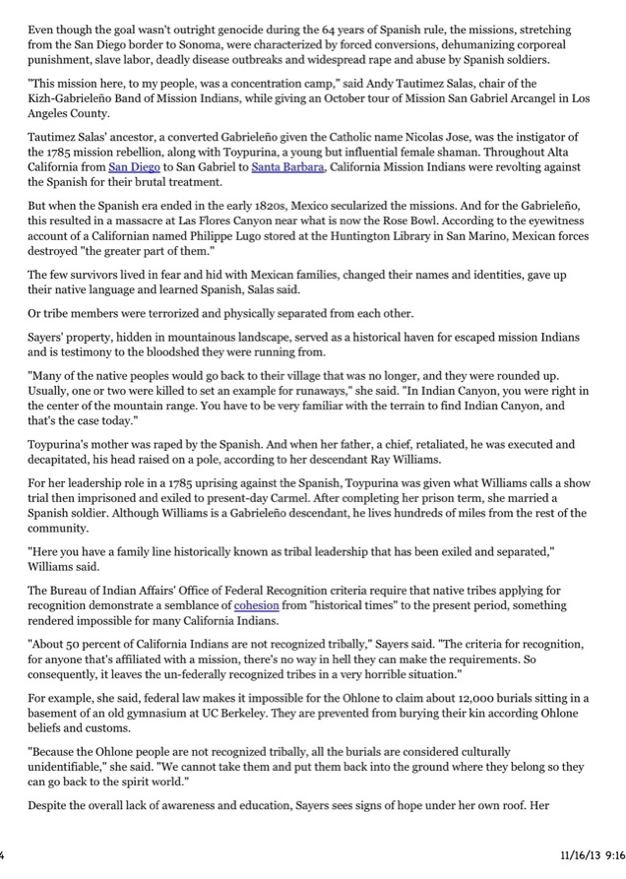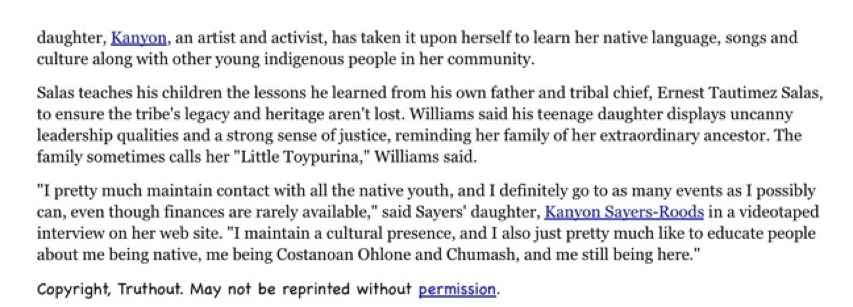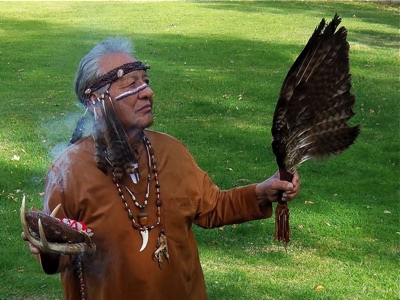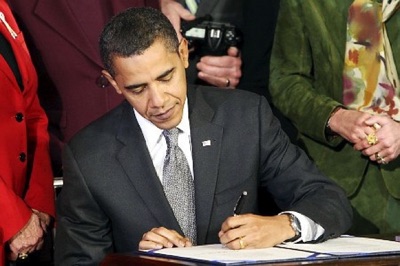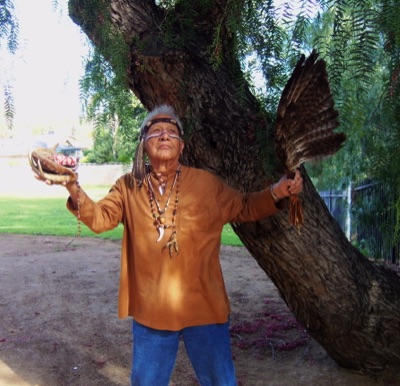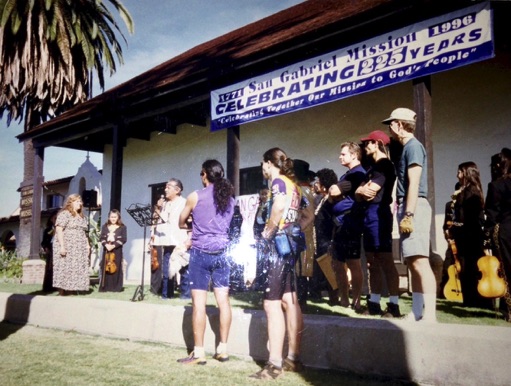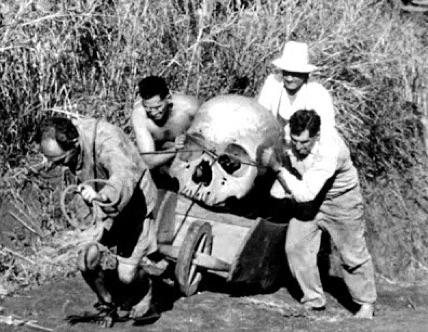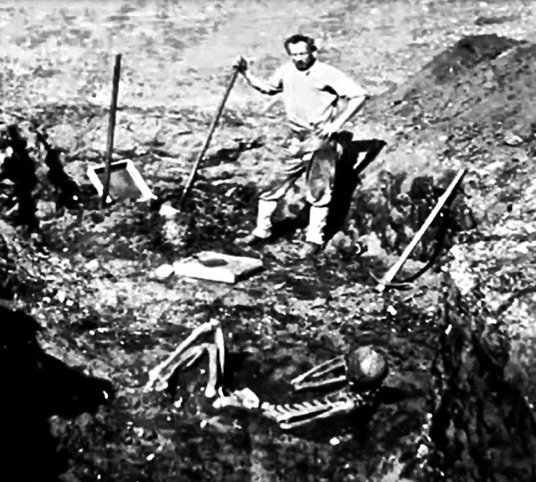

Gabrielenos who owned land in California
Prospero Dominguez, Manuel Antonio Perez , were Gabrieleno’s who recieved or owned land.
Prospero built a home by a creek and a hollow of sycamores just north of the mission near the old grist mill in present-day San Marino, according to Mexican land grant records. He raised livestock, tilled the land and planted a garden, some fruit trees and a vineyard on 23 acres that would later be deeded to him by the Mexican government--one of eight small grants given to the Indians of San Gabriel in the 1840s.
Victoria (Bartolomea) Reid, Gabrieleno, San Gabriel (ca 1808- 1868)
Victoria Bartolomea was a prestigious and powerful member of the Gabrieleno town “Comicrabit "on the outskirts of the pueblo of Los Angeles. Growing up in the San Gabriel Mission, Dona Eulalia Perez took Victoria under her wing and taught her the manners and traditions of a “fine Spanish Lady” (Hugo Reid Adobe). She married an Indian man, Pablo Maria and had four children with him. Hugo was immediately attracted to her and quickly went to the mission upon Pablo’s death in 1837. Being the daughter of the leader of the tribe, also known as the tomyaar, not only did she have power within the tribe but upon her marriage to the Scottish traveler Hugo Reid she gained indirect power within the European realm as well (McCawley 1996: 21).
Hugo Reid wrote a series of letters to the Los Angeles Star Newspaper about the Gabrielenos and boldly stated that the mission Indians were not well. He documented their customs and highlighted their sufferings. It is assumed that his information about their way of life came directly from Victoria Reid and her family.
Unfortunately there is not much written about Victoria as a powerful Indian woman. Although her legacy works against not one, but two social barriers in history (being an Indian and a woman) one must imagine the influence she had at the time. Women in her tribe must have revered her and Hugo and his accomplices probably used her for much of their information.
Not only was she affluent in society but she also was the owner of 128 acres of a pear orchard (granted to her after the secularization of the mission) as well as the Rancho Santa Anita present day Arcadia CA. When she married Hugo, he inherited the rancho but she kept the orchard in her name (McCawley 204). After Hugo’s death Victoria remained in their adobe home named Una Spina until it crumbled in an earthquake in 1855. She lived the rest of her life at the San Gabriel Mission and was buried there in 1868 after her death caused by smallpox (Hugo Reid Adobe).
Her legacy remains undaunted, her charm and intellect still resounds in the few histories written about her. She crossed boundaries when she married a white man; even Reid’s acquaintances did not accept her at first but she soon won them over with her charm and beauty.
United Nations Declaration on the Rights of
Indigenous Peoples
Adopted by General Assembly Resolution 61/295 on 13 September 2007
The General Assembly,
Guided by the purposes and principles of the Charter of the United Nations, and good faith in the fulfillment of the obligations assumed by States in accordance with the Charter,
Affirming that indigenous peoples are equal to all other peoples, while recognizing the right of all peoples to be different, to consider themselves different, and to be respected as such,
Affirming also that all peoples contribute to the diversity and richness of civilizations and cultures, which constitute the common heritage of humankind,
Affirming further that all doctrines, policies and practices based on or advocating superiority of peoples or individuals on the basis of national origin or racial, religious, ethnic or cultural differences are racist, scientifically false, legally invalid, morally condemnable and socially unjust,
Reaffirming that indigenous peoples, in the exercise of their rights, should be free from discrimination of any kind,
Concerned that indigenous peoples have suffered from historic injustices as a result of, inter alia, their colonization and dispossession of their lands, territories and resources, thus preventing them from exercising, in particular, their right to development in accordance with their own needs and interests,
Recognizing the urgent need to respect and promote the inherent rights of indigenous peoples which derive from their political, economic and social structures and from their cultures, spiritual traditions, histories and philosophies, especially their rights to their lands, territories and resources,
Recognizing also the urgent need to respect and promote the rights of indigenous peoples affirmed in treaties, agreements and other constructive arrangements with States,
Welcoming the fact that indigenous peoples are organizing themselves for political, economic, social and cultural enhancement and in order to bring to an end all forms of discrimination and oppression wherever they occur,
Convinced that control by indigenous peoples over developments affecting them and their lands, territories and resources will enable them to maintain and strengthen their institutions, cultures and traditions, and to promote their development in accordance with their aspirations and needs,
Recognizing that respect for indigenous knowledge, cultures and traditional practices contributes to sustainable and equitable development and proper management of the environment,
Emphasizing the contribution of the demilitarization of the lands and territories of indigenous peoples to peace, economic and social progress and development, understanding and friendly relations among nations and peoples of the world,
Recognizing in particular the right of indigenous families and communities to retain shared responsibility for the upbringing, training, education and well-being of their children, consistent with the rights of the child,
Considering that the rights affirmed in treaties, agreements and other constructive arrangements between States and indigenous peoples are, in some situations, matters of international concern, interest, responsibility and character,
Considering also that treaties, agreements and other constructive arrangements, and the relationship they represent, are the basis for a strengthened partnership between indigenous peoples and States,
Acknowledging that the Charter of the United Nations, the International Covenant on Economic, Social and Cultural Rights (2) and the International Covenant on Civil and Political Rights,2 as well as the Vienna Declaration and Program of Action,(3) affirm the fundamental importance of the right to self-determination of all peoples, by virtue of which they freely determine their political status and freely pursue their economic, social and cultural development,
Bearing in mind that nothing in this Declaration may be used to deny any peoples their right to self-determination, exercised in conformity with international law,
Convinced that the recognition of the rights of indigenous peoples in this Declaration will enhance harmonious and cooperative relations between the State and indigenous peoples, based on principles of justice, democracy, respect for human rights, non-discrimination and good faith,
Encouraging States to comply with and effectively implement all their obligations as they apply to indigenous peoples under international instruments, in particular those related to human rights, in consultation and cooperation with the peoples concerned,
Emphasizing that the United Nations has an important and continuing role to play in promoting and protecting the rights of indigenous peoples,
Believing that this Declaration is a further important step forward for the recognition, promotion and protection of the rights and freedoms of indigenous peoples and in the development of relevant activities of the United Nations system in this field,
Recognizing and reaffirming that indigenous individuals are entitled without discrimination to all human rights recognized in international law, and that indigenous peoples possess collective rights which are indispensable for their existence, well-being and integral development as peoples,
Recognizing that the situation of indigenous peoples varies from region to region and from country to country and that the significance of national and regional particularities and various historical and cultural backgrounds should be taken into consideration,
Solemnly proclaims the following United Nations Declaration on the Rights of Indigenous Peoples as a standard of achievement to be pursued in a spirit of partnership and mutual respect:
Article 1
Indigenous peoples have the right to the full enjoyment, as a collective or as individuals, of all human rights and fundamental freedoms as recognized in the Charter of the United Nations, the Universal Declaration of Human Rights(4) and international human rights law.
Article 2
Indigenous peoples and individuals are free and equal to all other peoples and individuals and have the right to be free from any kind of discrimination, in the exercise of their rights, in particular that based on their indigenous origin or identity.
Article 3
Indigenous peoples have the right to self-determination. By virtue of that right they freely determine their political status and freely pursue their economic, social and cultural development.
Article 4
Indigenous peoples, in exercising their right to self-determination, have the right to autonomy or self-government in matters relating to their internal and local affairs, as well as ways and means for financing their autonomous functions.
Article 5
Indigenous peoples have the right to maintain and strengthen their distinct political, legal, economic, social and cultural institutions, while retaining their right to participate fully, if they so choose, in the political, economic, social and cultural life of the State.
Article 6
Every indigenous individual has the right to a nationality.
Article 7
1. Indigenous individuals have the rights to life, physical and mental integrity, liberty and security of person.
2. Indigenous peoples have the collective right to live in freedom, peace and security as distinct peoples and shall not be subjected to any act of genocide or any other act of violence, including forcibly removing children of the group to another group.
Article 8
1. Indigenous peoples and individuals have the right not to be subjected to forced assimilation or destruction of their culture.
2. States shall provide effective mechanisms for prevention of, and redress for:
(a) Any action which has the aim or effect of depriving them of their integrity as distinct peoples, or of their cultural values or ethnic identities;
(b) Any action which has the aim or effect of dispossessing them of their lands, territories or resources;
(c) Any form of forced population transfer which has the aim or effect of violating or undermining any of their rights;
(d) Any form of forced assimilation or integration;
(e) Any form of propaganda designed to promote or incite racial or ethnic discrimination directed against them.
Article 9
Indigenous peoples and individuals have the right to belong to an indigenous community or nation, in accordance with the traditions and customs of the community or nation concerned. No discrimination of any kind may arise from the exercise of such a right.
Article 10
Indigenous peoples shall not be forcibly removed from their lands or territories. No relocation shall take place without the free, prior and informed consent of the indigenous peoples concerned and after agreement on just and fair compensation and, where possible, with the option of return.
Article 11
1. Indigenous peoples have the right to practice and revitalize their cultural traditions and customs. This includes the right to maintain, protect and develop the past, present and future manifestations of their cultures, such as archaeological and historical sites, artifacts, designs, ceremonies, technologies and visual and performing arts and literature.
2. States shall provide redress through effective mechanisms, which may include restitution, developed in conjunction with indigenous peoples, with respect to their cultural, intellectual, religious and spiritual property taken without their free, prior and informed consent or in violation of their laws, traditions and customs.
Article 12
1. Indigenous peoples have the right to manifest, practice, develop and teach their spiritual and religious traditions, customs and ceremonies; the right to maintain, protect, and have access in privacy to their religious and cultural sites; the right to the use and control of their ceremonial objects; and the right to the repatriation of their human remains.
2. States shall seek to enable the access and/or repatriation of ceremonial objects and human remains in their possession through fair, transparent and effective mechanisms developed in conjunction with indigenous peoples concerned.
Article 13
1. Indigenous peoples have the right to revitalize, use, develop and transmit to future generations their histories, languages, oral traditions, philosophies, writing systems and literatures, and to designate and retain their own names for communities, places and persons.
2. States shall take effective measures to ensure that this right is protected and also to ensure that indigenous peoples can understand and be understood in political, legal and administrative proceedings, where necessary through the provision of interpretation or by other appropriate means.
Article 14
1. Indigenous peoples have the right to establish and control their educational systems and institutions providing education in their own languages, in a manner appropriate to their cultural methods of teaching and learning.
2. Indigenous individuals, particularly children, have the right to all levels and forms of education of the State without discrimination.
3. States shall, in conjunction with indigenous peoples, take effective measures, in order for indigenous individuals, particularly children, including those living outside their communities, to have access, when possible, to an education in their own culture and provided in their own language.
Article 15
1. Indigenous peoples have the right to the dignity and diversity of their cultures, traditions, histories and aspirations which shall be appropriately reflected in education and public information.
2. States shall take effective measures, in consultation and cooperation with the indigenous peoples concerned, to combat prejudice and eliminate discrimination and to promote tolerance, understanding and good relations among indigenous peoples and all other segments of society.
Article 16
1. Indigenous peoples have the right to establish their own media in their own languages and to have access to all forms of non-indigenous media without discrimination.
2. States shall take effective measures to ensure that State-owned media duly reflect indigenous cultural diversity. States, without prejudice to ensuring full freedom of expression, should encourage privately owned media to adequately reflect indigenous cultural diversity.
Article 17
1. Indigenous individuals and peoples have the right to enjoy fully all rights established under applicable international and domestic labour law.
2. States shall in consultation and cooperation with indigenous peoples take specific measures to protect indigenous children from economic exploitation and from performing any work that is likely to be hazardous or to interfere with the child’s education, or to be harmful to the child’s health or physical, mental, spiritual, moral or social development, taking into account their special vulnerability and the importance of education for their empowerment.
3. Indigenous individuals have the right not to be subjected to any discriminatory conditions of labour and, inter alia, employment or salary.
Article 18
Indigenous peoples have the right to participate in decision-making in matters which would affect their rights, through representatives chosen by themselves in accordance with their own procedures, as well as to maintain and develop their own indigenous decision-making institutions.
Article 19
States shall consult and cooperate in good faith with the indigenous peoples concerned through their own representative institutions in order to obtain their free, prior and informed consent before adopting and implementing legislative or administrative measures that may affect them.
Article 20
1. Indigenous peoples have the right to maintain and develop their political, economic and social systems or institutions, to be secure in the enjoyment of their own means of subsistence and development, and to engage freely in all their traditional and other economic activities.
2. Indigenous peoples deprived of their means of subsistence and development are entitled to just and fair redress.
Article 21
1. Indigenous peoples have the right, without discrimination, to the improvement of their economic and social conditions, including, inter alia, in the areas of education, employment, vocational training and retraining, housing, sanitation, health and social security.
2. States shall take effective measures and, where appropriate, special measures to ensure continuing improvement of their economic and social conditions. Particular attention shall be paid to the rights and special needs of indigenous elders, women, youth, children and persons with disabilities.
Article 22
1. Particular attention shall be paid to the rights and special needs of indigenous elders, women, youth, children and persons with disabilities in the implementation of this Declaration.
2. States shall take measures, in conjunction with indigenous peoples, to ensure that indigenous women and children enjoy the full protection and guarantees against all forms of violence and discrimination.
Article 23
Indigenous peoples have the right to determine and develop priorities and strategies for exercising their right to development. In particular, indigenous peoples have the right to be actively involved in developing and determining health, housing and other economic and social programs affecting them and, as far as possible, to administer such programs through their own institutions.
Article 24
1. Indigenous peoples have the right to their traditional medicines and to maintain their health practices, including the conservation of their vital medicinal plants, animals and minerals. Indigenous individuals also have the right to access, without any discrimination, to all social and health services.
2. Indigenous individuals have an equal right to the enjoyment of the highest attainable standard of physical and mental health. States shall take the necessary steps with a view to achieving progressively the full realization of this right.
Article 25
Indigenous peoples have the right to maintain and strengthen their distinctive spiritual relationship with their traditionally owned or otherwise occupied and used lands, territories, waters and coastal seas and other resources and to uphold their responsibilities to future generations in this regard.
Article 26
1. Indigenous peoples have the right to the lands, territories and resources which they have traditionally owned, occupied or otherwise used or acquired.
2. Indigenous peoples have the right to own, use, develop and control the lands, territories and resources that they possess by reason of traditional ownership or other traditional occupation or use, as well as those which they have otherwise acquired.
3. States shall give legal recognition and protection to these lands, territories and resources. Such recognition shall be conducted with due respect to the customs, traditions and land tenure systems of the indigenous peoples concerned.
Article 27
States shall establish and implement, in conjunction with indigenous peoples concerned, a fair, independent, impartial, open and transparent process, giving due recognition to indigenous peoples’ laws, traditions, customs and land tenure systems, to recognize and adjudicate the rights of indigenous peoples pertaining to their lands, territories and resources, including those which were traditionally owned or otherwise occupied or used. Indigenous peoples shall have the right to participate in this process.
Article 28
1. Indigenous peoples have the right to redress, by means that can include restitution or, when this is not possible, just, fair and equitable compensation, for the lands, territories and resources which they have traditionally owned or otherwise occupied or used, and which have been confiscated, taken, occupied, used or damaged without their free, prior and informed consent.
2. Unless otherwise freely agreed upon by the peoples concerned, compensation shall take the form of lands, territories and resources equal in quality, size and legal status or of monetary compensation or other appropriate redress.
Article 29
1. Indigenous peoples have the right to the conservation and protection of the environment and the productive capacity of their lands or territories and resources. States shall establish and implement assistance programs for indigenous peoples for such conservation and protection, without discrimination.
2. States shall take effective measures to ensure that no storage or disposal of hazardous materials shall take place in the lands or territories of indigenous peoples without their free, prior and informed consent.
3. States shall also take effective measures to ensure, as needed, that programs for monitoring, maintaining and restoring the health of indigenous peoples, as developed and implemented by the peoples affected by such materials, are duly implemented.
Article 30
1. Military activities shall not take place in the lands or territories of indigenous peoples, unless justified by a relevant public interest or otherwise freely agreed with or requested by the indigenous peoples concerned.
2. States shall undertake effective consultations with the indigenous peoples concerned, through appropriate procedures and in particular through their representative institutions, prior to using their lands or territories for military activities.
Article 31
1. Indigenous peoples have the right to maintain, control, protect and develop their cultural heritage, traditional knowledge and traditional cultural expressions, as well as the manifestations of their sciences, technologies and cultures, including human and genetic resources, seeds, medicines, knowledge of the properties of fauna and flora, oral traditions, literatures, designs, sports and traditional games and visual and performing arts. They also have the right to maintain, control, protect and develop their intellectual property over such cultural heritage, traditional knowledge, and traditional cultural expressions.
2. In conjunction with indigenous peoples, States shall take effective measures to recognize and protect the exercise of these rights.
Article 32
1. Indigenous peoples have the right to determine and develop priorities and strategies for the development or use of their lands or territories and other resources.
2. States shall consult and cooperate in good faith with the indigenous peoples concerned through their own representative institutions in order to obtain their free and informed consent prior to the approval of any project affecting their lands or territories and other resources, particularly in connection with the development, utilization or exploitation of mineral, water or other resources.
3. States shall provide effective mechanisms for just and fair redress for any such activities, and appropriate measures shall be taken to mitigate adverse environmental, economic, social, cultural or spiritual impact.
Article 33
1. Indigenous peoples have the right to determine their own identity or membership in accordance with their customs and traditions. This does not impair the right of indigenous individuals to obtain citizenship of the States in which they live.
2. Indigenous peoples have the right to determine the structures and to select the membership of their institutions in accordance with their own procedures.
Article 34
Indigenous peoples have the right to promote, develop and maintain their institutional structures and their distinctive customs, spirituality, traditions, procedures, practices and, in the cases where they exist, juridical systems or customs, in accordance with international human rights standards.
Article 35
Indigenous peoples have the right to determine the responsibilities of individuals to their communities.
Article 36
1. Indigenous peoples, in particular those divided by international borders, have the right to maintain and develop contacts, relations and cooperation, including activities for spiritual, cultural, political, economic and social purposes, with their own members as well as other peoples across borders.
2. States, in consultation and cooperation with indigenous peoples, shall take effective measures to facilitate the exercise and ensure the implementation of this right.
Article 37
1. Indigenous peoples have the right to the recognition, observance and enforcement of treaties, agreements and other constructive arrangements concluded with States or their successors and to have States honor and respect such treaties, agreements and other constructive arrangements.
2. Nothing in this Declaration may be interpreted as diminishing or eliminating the rights of indigenous peoples contained in treaties, agreements and other constructive arrangements.
Article 38
States in consultation and cooperation with indigenous peoples, shall take the appropriate measures, including legislative measures, to achieve the ends of this Declaration.
Article 39
Indigenous peoples have the right to have access to financial and technical assistance from States and through international cooperation, for the enjoyment of the rights contained in this Declaration.
Article 40
Indigenous peoples have the right to access to and prompt decision through just and fair procedures for the resolution of conflicts and disputes with States or other parties, as well as to effective remedies for all infringements of their individual and collective rights. Such a decision shall give due consideration to the customs, traditions, rules and legal systems of the indigenous peoples concerned and international human rights.
Article 41
The organs and specialized agencies of the United Nations system and other intergovernmental organizations shall contribute to the full realization of the provisions of this Declaration through the mobilization, inter alia, of financial cooperation and technical assistance. Ways and means of ensuring participation of indigenous peoples on issues affecting them shall be established.
Article 42
The United Nations, its bodies, including the Permanent Forum on Indigenous Issues, and specialized agencies, including at the country level, and States shall promote respect for and full application of the provisions of this Declaration and follow up the effectiveness of this Declaration.
Article 43
The rights recognized herein constitute the minimum standards for the survival, dignity and well-being of the indigenous peoples of the world.
Article 44
All the rights and freedoms recognized herein are equally guaranteed to male and female indigenous individuals.
Article 45
Nothing in this Declaration may be construed as diminishing or extinguishing the rights indigenous peoples have now or may acquire in the future.
Article 46
1. Nothing in this Declaration may be interpreted as implying for any State, people, group or person any right to engage in any activity or to perform any act contrary to the Charter of the United Nations or construed as authorizing or encouraging any action which would dismember or impair, totally or in part, the territorial integrity or political unity of sovereign and independent States.
2. In the exercise of the rights enunciated in the present Declaration, human rights and fundamental freedoms of all shall be respected. The exercise of the rights set forth in this Declaration shall be subject only to such limitations as are determined by law and in accordance with international human rights obligations. Any such limitations shall be non-discriminatory and strictly necessary solely for the purpose of securing due recognition and respect for the rights and freedoms of others and for meeting the just and most compelling requirements of a democratic society.
3. The provisions set forth in this Declaration shall be interpreted in accordance with the principles of justice, democracy, respect for human rights, equality, non-discrimination, good governance and good faith.
(2) See resolution 2200 A (XXI), annex.
(3) A/CONF.157/24 (Part I), chap. III.
(4) Resolution 217 A (III).
BLOOD QUANTUM
Did you know that the Native American Indian People in the United States of America have to prove what fraction or degree of “Indian Blood Quantum” that they have in order to be acknowledged and recognized by the United States Federal Government. They are deliberately and intentionally racially discriminated against because they are the only ethnic group or race of human beings in the United States of America that have to document and record their complete “Indian” ancestry and “Indian” lineage to the Bureau Of Indian Affairs (B.I.A.) which is an agency of the United States Federal Government. They will actually receive a “Pedigree Slip” called a Certificate Degree Of Indian Blood (C.D.I.B.) with their fraction or degree of “Indian Blood Quantum” or “Blood Quantum” on a piece of paper: 3/4-1/2-1/4-1/8-1/16-1/32. This will ensure that if they do not have children with another “Indian” their ethnic group or race of human beings will continue to decrease and become more extinct while every other ethnic group or race of human beings will continue to increase and become more distinct. The Native American Indian People in the United States of America must eliminate and eradicate this form of paper genocide and ethnocide because we do not need to prove to anyone on a piece of paper, like an animal or a breed, that we carry the “Indigenous” blood of our ancestors. JAMES AGUIRRE

Life at Marano Beach, the lost Barrio Beach of the
San Gabriel Valley





